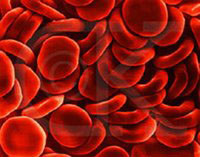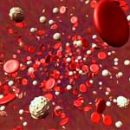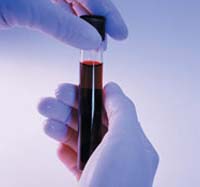Sickle-cell anemia refers to hereditary blood diseases and is observed in people who inherited two defective genes from parents. For the disease, the periods of relative well-being, which are replaced by periods of exacerbation.
Content
The concept of sickle-cell anemia
 Sick-shaped cell anemia is a serious hereditary blood disease for which the periods of relative health, alternating with crises (diseases of the exacerbation of the disease). The victims of this disease observes constant anemia, and they are very susceptible to various serious infections. Anemia is a condition in which there is a sufficient amount of substance carrying oxygen to the tissues of the body. It can lead to weakness and even the development of jaundice.
Sick-shaped cell anemia is a serious hereditary blood disease for which the periods of relative health, alternating with crises (diseases of the exacerbation of the disease). The victims of this disease observes constant anemia, and they are very susceptible to various serious infections. Anemia is a condition in which there is a sufficient amount of substance carrying oxygen to the tissues of the body. It can lead to weakness and even the development of jaundice.
Sick-shaped cell anemia is observed only in those who inherited 2 genes (one defective gene from each parent), which cause products of defective hemoglobin, called hemoglobin of sickle cells. Hemoglobin is a red pigment that gives coloring red blood cells (red blood cells), which transfers oxygen to the tissues of the body. Hemoglobin captures oxygen during blood circulation in the lungs. During the circulation of oxygenated blood (blood saturated with oxygen), hemoglobin loses oxygen, which goes into the cells of the body. Although the hemoglobin of sickle cells functions normally when the oxygen is transferred, after the oxygen loss, it has a trend of sickle casing. As a result, normal round and pearly coated red blood cells become durable or sickle-shaped cellular. As the blood circulates through the lungs and absorbs more oxygen, hemoglobin restores its normal form.
Red blood cells containing hemoglobin of sickle cells, very fragile. This fragility means that red blood cells are easily destroyed, causing a resistant anemia. Red blood cells containing sickle-cell hemoglobin can also stick together and clog small capillaries (tiny blood vessels connecting arteries and veins) and thus prevent access to the oxygen and the necessary nutrients into the surrounding tissues.
The positive torque of this disease is that sickle-shaped cell hemoglobin protects against a malarious infection.
The Cerp-Cell Hemoglobin gene is most often found in the Black Population, although sometimes there are among the residents of the Mediterranean, immigrants from India and Asia. In the United States, approximately 1 of each 10 black inhabitants carry one gene of sampling anemia. The carriers of one gene are usually completely healthy and have no symptoms of the disease, they simply have a predisposition to the disease.
In general, people with sickle-shaped anemia are able to conduct a full-fledged lifestyle and perform any work, to have a family and fully participate in public and political life or, for example, to engage in teaching activities. Many patients live to 40 and 50 years old, and some even up to 70.
Causes of the development of anemia
If both parents bear the cinema anemia gene, then their children with a 25 percent probability may have sick-shaped cell anemia and there is a 50 percent probability to inherit only the predisposition to it. If the gene of the sickle-cell anemia is only one parent, there is absolutely no risk that the child will have a sick-shaped cell anemia, although there is a 50 percent chance that the child inherits one gene of sickle cell anemia.
Basic symptoms of the disease
Symptoms of sickle-shaped anemia are divided into two main categories. Due to the fragility of red blood cells, anemia is always observed, which can lead to loss of consciousness, makes a patient physically less hardy and can cause jaundice (associated with an excessive decay of hemoglobin).
In addition, the periodic blockage of small capillaries in any part of the body can lead to a wide range of different symptoms. Almost impossible to describe «Typical patient», suffering from sickle-cell anemia, since the symptoms and their severity are widely vary. Some characteristic features are common for almost all patients with sickle-cell anemia.
Typically, newborns are quite healthy, they have normal weight and normally develop, they do not manifest any symptoms until 3 months of age. The first signs of sickle-cell anemia in the infant are usually swelling and painfulness of the hands or stop, weakness and curvature of the limbs and sometimes, somewhat later, the failure of walking. This symptom is the result of blockage by erythrocytes of capillaries of small bones of brushes and stop and blood flow disorders. Erythrocytes fall out of a liquid blood and postponed in capillaries in the form of a precipitate. The accumulation of red blood cells is gradually dissolved in itself, but as long as it does not happen, a doctor's help is required to soften pain and detect possible concomitant diseases. A child with sickle-cell anemia usually looks pale, perhaps slightly yellow, but in the rest of the way, as a rule, healthy.
The only very serious complication of sickle cell anemia in a child up to 5 years of age is infection. The accumulation of red blood cells and the blockage of the capillaries in the spleen, the body, which is normally filtered off the bacteria from the bloodstream, occurs during the first years of life, which makes a child especially susceptible to death infection - sepsis. Therefore, parents of small children suffering from sickle-cell anemia warn them to be attentive and missed early symptoms of infection, such as irritability, nervousness, elevated temperature and poor appetite.
Parents must immediately apply for medical care if a child has any of these symptoms. If when infected with blood, it is fairly early to begin to apply antibiotics, fatal complications can be avoided. After 5 years of age, when the child has already developed the corresponding natural antibodies to bacteria, the likelihood of a deadly bacterial infection is significantly reduced.
The problem of school-age children with sickle-cell anemia is usually an episodic blockage by erythrocytes of large bone capillaries. In most cases, these episodes proceed relatively easily, only weak bone pains are observed.
With age, the process of blockage of capillaries may affect other organs. If this happens, for example, in the lungs, a serious respiratory disease is developing. Very rare complication in patients with sickle-cell anemia - blockage of vessels of the brain, leading to a stroke.
Teenagers with sickle-shaped anemia are concerned and concern due to the fact that their physical development is usually delayed for 2-3 years. Such teenagers usually less thanks than their classmates, they are often teased for delay in sexual development. However, in time, sexual maturity still comes, and studies show that women with sickle-cell anemia can normally carry out their childbearing function. Women with sickle-cell anemia are definitely able to enter and give birth to normal children, but during pregnancy they increase the risk of complications that can lead to miscarriage, premature birth or strengthening anemia from the mother. Such pregnant women should be under the supervision of a gynecologist having a special pregnancy experience with high risk. During the pregnancy, such women may need blood transfusion.
In adults with sickle-cell anemia, symptoms of chronic (constant or long) blockage of lung and kidney capillaries can be found, and chronic pulmonary or renal failure can develop. These two complications lead to early death of some patients with sickle-shaped anemia.
Other patients may occur the clogging of the retinal capillaries of the eye, which ultimately can lead to blindness.
Diagnosis of the disease
Although symptoms of sickle-cell anemia are rarely manifested until 3 months of age, the diagnosis can be delivered at any age. The fetal sickle-shaped anemia can be detected using a fret bubble puncture (fence of the fetal waters with the help of a needle entered into the uterus through the abdominal wall). The amniotic fluid contains the cells of the fetus, and in the cells there are genes responsible for the production of hemoglobin, so you can explore directly the genes of the fetus. This testing is very important for the prevention of fatal complications, which are characteristic of children with sickle cell anemia in the first years of life.
Healthy carriers of a sign of sickle-cell anemia can also be easily identified using a simple blood test.
Treatment and prevention of sickle-cell anemia
The methods of treatment of sickle-cell anemia do not exist. However, the overall improvement in medical care was the possibility of a longer and healthy life of children suffering from this disease. Currently, attention is paid to proper nutrition, educational measures and prevention of infections. It is very important to maintain contact with a primary care doctor who is familiar with the early signs of complications arising from sickle cell anemia.
Especially important permanent dispensary observation of young children with sickle-cell anemia to prevent early life-threatening infectious complications. Anemia may be intensified as a result of infection or sudden increase in spleen, it may be necessary to hospitalize a child for treatment from infection or pain. Pregnancy and surgical interventions, as well as eye disease, require the attention of specialists who have special experience with patients suffering from sickle cell anemia.
The use of vaccine against pneumococci and early antibiotic therapy saved the lives of many small children with sickle-shaped anemia. With weakening bone pains, you can cope at home with peace, consumption of sufficient liquid and painkillers released without a recipe. Sometimes these bouts of pain can be sufficiently heavy, and the hospitalization of the child may be required to get rid of them. Most children with sickle-shaped anemia are normally developed in mental terms, can successfully learn from school, missing quite a few days due to painful crises.
With severe respiratory diseases, hospitalization is required for the garden of the oxygen child and, if necessary, for blood transfusion.
For the treatment of patients with clogging capillaries of the eye retina, new methods of therapy can be applied using laser. It is recommended to observe an ophthalmologist to identify lesions in the initial stage, before they lead to blindness.
Sickle-cell anemia cannot be warned. However, married couples with a sign of sickle-cell anemia should be appropriate for genetic advice.









